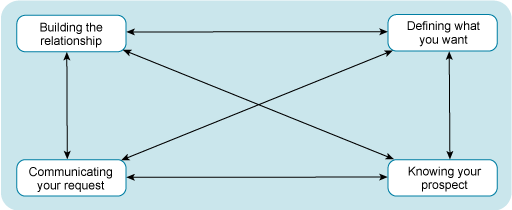The process approach
The second approach to asking – the process approach – does not provide a ‘recipe’ to follow in the same way. It sees asking as a creative activity: creating a suitable opportunity for someone to give. It is based on four key aspects of the process of asking, but without presenting these as a series of steps. The business of asking is essentially relational and interactive. Figure 3 and Box 2 summarise the relationship between the four aspects.
Box 2 The process of asking
Each of the elements in Figure 3 involves you in making judgements and identifying options in light of the information you are receiving.
1 Knowing your prospect
You do not have to be personally acquainted with a prospect before you can ask for anything, but you have to make some preliminary attempt to assess how they are likely to respond and the sorts of thing they support. This is not just a matter of detailed, initial research. Someone collecting for an environmental organisation outside a supermarket on a Saturday morning is continually making quick judgements of people based on eye contact, what’s in their trolley, what they are wearing, and so forth. These signals will contribute to some sort of initial assumptions about reasons for responding to any request for support.
2 Defining what you want
You need to be specific about what you want from an individual prospect and why you want it. You will have to indicate a level of donation or a type of involvement, and the reasons you believe it merits their consideration. Offer scope for them to explore, discuss and negotiate. What you are looking for is a request that they can define and respond to in ways that are appropriate and meaningful to their needs and concerns.
3 Communicating your request
There is no ideal way of actually putting a particular request. Communicating your request involves thinking through how your proposal is likely to be received and amending your style if necessary. Link your request with other information and requests your prospect might have received from your organisation.
4 Building the relationship
You need to create – or sustain – an appropriate relationship. How far are you asking your prospect simply to slot into a standard relationship – as a member, an occasional or one-off contributor, a long-term supporter, a benefactor? Alternatively, what is the scope for an individual negotiation of the relationship in light of his or her concerns and aspirations? Although the request may be for a specific purpose, you will want to create a basis for both of you to develop the relationship further.
There is much common ground between the performance and the process approaches to asking for support from a potential contributor. You can use either or both as a basis for planning and reviewing the way you make specific requests. In practice, you have or will develop a style and an approach with which you are comfortable. But however you ask, one other feature of one-to-one asking still has to be considered:
A superb personal performance and a flawlessly sensitive and flexible process will not guarantee you the outcome you seek.
This is not your fault, nor the fault of the prospect. Even if fundraising uses terms such as ‘prospect’, you are not in the technical business of oil exploration. You are engaged in a much more fragile business of fostering new relationships and identities. You are asking people to change, to be a bit different, to adjust their ideas of themselves. It is hardly surprising, therefore, that many people are not always prepared to make these changes just because you ask them and when you ask them.
It is in the nature of this sort of work with individual donors and supporters that you will often fail – or not succeed immediately. The most important skill you need in this interpersonal area of work is the ability to handle the answer ‘no’ and yet still continue.
While you need to have a strong personal commitment to the success of the individual request, you also need to place it firmly in the context of the bigger picture. Concentrate on learning from the experience. The person whose donation you are soliciting is an individual among many other possibilities. In the words of a successful appeals manager: ‘“No” today does not imply “No” tomorrow. I always try to retain the relationship.’

